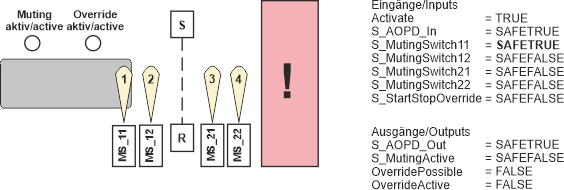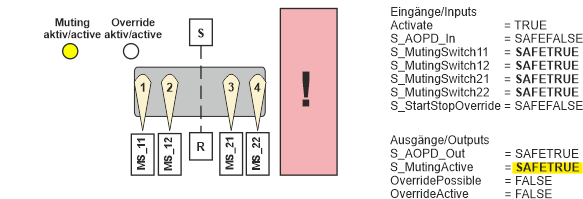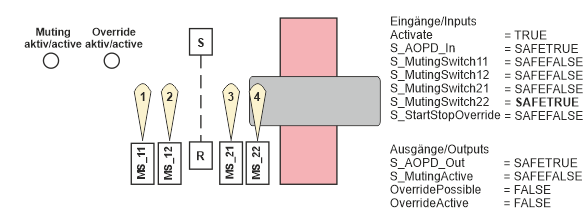Functional description
Dieses Thema enthält die folgenden Abschnitte:
- Muting operation (without override function)
- Muting errors
- Override function
- Example of a muting operation (without override function)
- Example of a muting operation (with override function)
- Start-up inhibit (S_StartReset)
The safety-related SF_MutingSeq function block executes the function "sequential muting with four sensors and override function" within an application.
To this end, it evaluates the following signals:
- the signals of four muting sensors,
- the status signal of the safety-related equipment (light grid),
- the feedback signal from the muting lamp,
- an enable signal for the muting operation,
- a request signal for the override function.
A start-up inhibit can be specified at S_StartReset.
The function block switches the enable signal at the S_AOPD_Out output in accordance with the input signals present. It executes stop category 0 at this output.
| Hinweis
The signal at the S_AOPD_Out output is the enable signal for the entire process. In order to process the enable or, equally, the request for the defined safe state in the functional safety system, the signal must be used in the safety logic in such a way that a SAFEFALSE signal at the S_AOPD_Out output stops the zone of operation from being used. |
| Hinweis
Depending on the result of the risk analysis, optical, mechanical or inductive sensors such as reflection light sensors, mechanical or inductive switches can be used as muting sensors. Optical sensors serve as examples in the help information. |
Muting operation (without override function)
The overall muting operation is divided into different muting sequences.
| Hinweis
Only the material flow direction from muting sensors S_MutingSwitch11  S_MutingSwitch12 to muting sensors S_MutingSwitch21 S_MutingSwitch12 to muting sensors S_MutingSwitch21 S_MutingSwitch22 is described in the following (forward direction). This is illustrated in the graphic in the function block overview. S_MutingSwitch22 is described in the following (forward direction). This is illustrated in the graphic in the function block overview.The function block also supports the opposite material flow direction from muting sensors S_MutingSwitch22  S_MutingSwitch21 to muting sensors S_MutingSwitch12 S_MutingSwitch21 to muting sensors S_MutingSwitch12 S_MutingSwitch11 (backwards direction). The functional sequence remains identical. S_MutingSwitch11 (backwards direction). The functional sequence remains identical. |
- Protecting the zone of operation.The safety-related equipment is active when muting is not active: If the function block does not detect an active muting operation at the muting inputs, a SAFEFALSE signal from the light grid ("object detected") leads to the defined safe state SAFEFALSE at the S_AOPD_Out output (e.g., "stop machine").
- Activating the muting operation.The safety-related equipment is deactivated: When the muting sensors located before the safety-related equipment switch from SAFEFALSE to SAFETRUE one after the other (i.e., first S_MutingSwitch11 and then S_MutingSwitch12) (because both have detected an object), the muting operation is activated and the safety-related equipment deactivated.
- Muting operation is active.The safety-related equipment is deactivated for as long as the muting operation is active and the sensors detect an object permissible for the muting operation.
A SAFEFALSE signal from the light grid ("object detected") does in this case not cause the S_AOPD_Out output to switch to the defined safe state SAFEFALSE (e.g., "stop machine").
The muting operation remains active as long as the requirements for a valid muting sequence are met and when the muting operation is completed properly within the maximum muting time set at MaxMutingTime. If it is not, the S_AOPD_Out output switches to the defined safe state SAFEFALSE (e.g., "stop machine"). - Completing the muting operation.The safety-related equipment is active again. The muting operation is complete when the first muting sensor located behind the safety-related equipment (at the S_MutingSwitch21 input) switches back from SAFETRUE to SAFEFALSE, i.e., an object is no longer detected in the detection area. The safety-related equipment is reactivated at the same time when the S_MutingActive output switches to SAFEFALSE.
| Weitere Infos
Refer also to the "Muting errors" section in this context. |
Muting errors
Errors which occur during the muting operation are called muting errors. As a result, muting is interrupted and the safety-related equipment gets activated. The safety-related equipment can then be temporarily deactivated by means of the override function (see below).
Muting errors are:- Invalid muting sequences which always occur if the following valid muting operation is not adhered to:
- For a material flow direction from left to right: first, S_MutingSwitch11 must become SAFETRUE and subsequently S_MutingSwitch12. Both inputs must remain SAFETRUE until S_MutingSwitch21 and then S_MutingSwitch22 also become SAFETRUE.
- For a material flow direction from right to left: first, S_MutingSwitch22 must become SAFETRUE and subsequently S_MutingSwitch21. Both inputs must remain SAFETRUE until S_MutingSwitch12 and then S_MutingSwitch11 also become SAFETRUE.
- The maximum muting time MaxMutingTime has elapsed.
If override is not requested in the event of a muting error, the outputs behave in the following way:
- the S_AOPD_Out output switches to the defined safe state SAFEFALSE (e.g., "stop machine"),
- the Error output switches to TRUE.
Override function
If the muting is interrupted by an error (e.g., the maximum muting time MaxMutingTime has elapsed because of an impermissible object), the safety-related equipment gets activated. This can be temporarily deactivated by the override function, e.g., to clear the zone of operation from the impermissible object.
The override function can only be used in the event of a previous muting error. The sequence is then as follows:- Normal sequence of the muting operation as described in the steps 1-3 above.
- Protecting the zone of operation by activating the safety-related equipment.
- Activating the muting operation and deactivating the safety-related equipment by the muting.
- A muting error occurs.
The muting gets interrupted, e.g., by an impermissible object. The Error output switches to TRUE and the S_AOPD_Out output switches to the defined safe state SAFEFALSE (e.g., "stop machine"). Now, an override operation is possible (OverridePossible output = TRUE). - Override is started by the operator.
An override operation can be started by a SAFETRUE signal at the S_StartStopOverride input, if the OverridePossible output = TRUE. This initiates the override timer (MaxOverrideTime input). The start is caused by activating the connected control device and must be maintained for the overall override duration (e.g., by a key switch).
The safety-related equipment is deactivated for as long as the override operation is active. A FALSE signal from the light grid ("object detected") does not then cause the S_AOPD_Out output to switch to the defined safe state SAFEFALSE (e.g., "stop machine"). Now, the impermissbile object can be removed from the zone of operation. - Interrupting or exiting the override operation.
The override operation gets interrupted as soon as the operator releases the control device (e.g., a key switch) (S_StartStopOverride input = SAFEFALSE). The output OverrideActive becomes FALSE and S_AOPD_Out switches to the defined safe state SAFEFALSE (e.g., "stop machine") and the override timer MaxOverrideTime continues to run. The override operation can be restarted as long as MaxOverrideTime has not elapsed. Override gets automatically exited when both muting sensors and the light grid detect no more object or when the override timer MaxOverrideTime has elapsed.
Example of a muting operation (without override function)
The graphic below shows an example of a muting operation.
| Hinweis
In the graphic, only the values of the inputs and outputs which are relevant for this illustration are given. |
Explanatory notes:
- MS_11: Muting sensor 1, connected to function block input S_MutingSwitch11 and
MS_12: Muting sensor 2, connected to function block input S_MutingSwitch12.
These two sensors are positioned before the safety-related equipment in the material flow direction of the assembly conveyor.
The detection areas of the muting sensors are shown as "yellow light beams". - MS_21: Muting sensor 3, connected to function block input S_MutingSwitch21 and
MS_22: Muting sensor 4, connected to function block input S_MutingSwitch22.
These two sensors are positioned behind the safety-related equipment in the material flow direction of the assembly conveyor. - Signaling unit (e.g., lamp) "muting active", controlled via function block output S_MutingActive.
- S/R: Safety-related equipment (e.g., light grid), consisting of a transmitter (S) and a receiver (R), connected to function block input S_AOPD_In. The function of this safety-related equipment is deactivated/activated by means of the muting operation.
Example of a muting operation (with override function)
In the event of an error during the activated muting (S_MutingActive = SAFETRUE) in the muting operation described in the example above, muting is inactive. All requirements for an override operation are then met and the further sequence is indicated below.
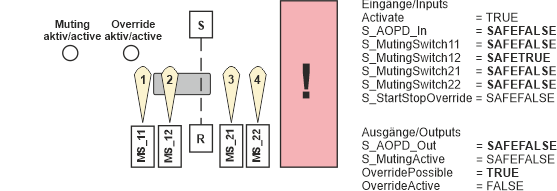 |
|
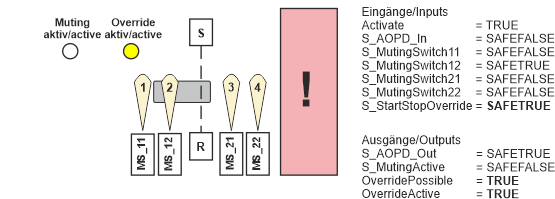 |
|
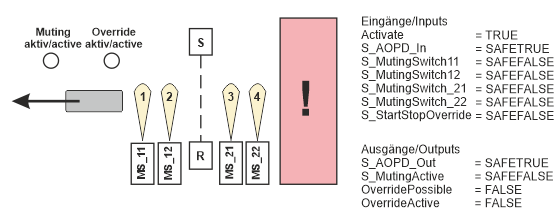 |
|
| Hinweis
As the override operation in this example has been completed within the time slot specified at the MaxOverrideTime input, the S_AOPD_Out output remains SAFETRUE and no error is detected (Error remains FALSE). Exceeding would result in an error (Error output = TRUE) and the S_AOPD_Out output would be switched to the defined safe state SAFEFALSE (e.g., "switch off machine"). |
Start-up inhibit (S_StartReset)
S_StartReset is used to specify the start-up inhibit after activating the function block and/or starting the Sicherheitssteuerung.
| S_StartReset = SAFEFALSE | After the Sicherheitssteuerung has been started up and/or the function block has been activated at input Activate, the start-up inhibit is active. The start-up inhibit is only removed if there is a positive signal edge at the Reset input.Refer to the first warning below this table. |
| S_StartReset = SAFETRUE | After the Sicherheitssteuerung has been started up and/or the function block has been activated at input Activate, no start-up inhibit is active.Refer to the second warning below this table. |
Removing the start-up inhibit by means of a positive signal edge at the Reset input can cause the S_AOPD_Out output to switch to SAFETRUE immediately (depending on the status of the other inputs).
|
WARNUNG
|
Unintended start-up
|
|
WARNUNG
|
Non-conformance to safety function requirements
|

